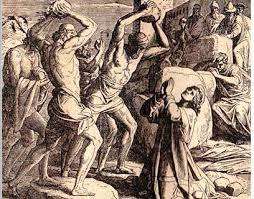

The History of Crucifixion: A Glimpse
Dr. Shaibu Abraham
"For the joy of accomplishing the goal set before Him, Jesus endured the cross, disregarding the shame...Consider and meditate on Him who endured from sinners such bitter hostility against Himself so that you will not grow weary and lose heart" (Heb. 12:2-3).
Christianity is the only religion that boasts of its leader who suffered violent and abominable death and worship him as "crucified God". Apostle Paul acknowledges that the message of Christ crucified will be a stumbling block to Jews and folly to Gentiles (1 Cor. 1:23). It is not an inherently attractive message. The world looks at the cross and sees weakness, irrationality, hate, and disgust. In the ancient world, there was no punishment more painful, terrifying, and de-humanizing than the cross. It is not simply that Jesus died or even that he was put to death by corrupt people; it was that he endured the death reserved only for the lowest and most despised.
In the early decades of the Christian movement the scandal of the cross was the most self-evident thing about it. Even though the gospel writers describe the details of cruelty Jesus endured in the act of crucifixion by the Roman soldiers, they did not explain the details of the dreadful agony of crucifixion itself, instead tersely termed that "he was crucified" (Mk. 15:24). However, going through the literature of antiquity we can get a glimpse of the cruelty committed in crucifixion. In the following pages we shall briefly delve into the history of crucifixion to understand the violent and horrendous nature of brutality that Jesus Christ suffered.
Crucifixion in the Pre-Roman World
The history of crucifixion can be traced back to the Egyptians (Genesis 40:19) and the Persians (Esther 7:10). Herodotus, the ancient Greek historian notes that the Persians practiced crucifixion as a form of execution. He reports that Darius (512–485 B.C.) had 3000 inhabitants of Babylon crucified. Other ancient sources also speak of the use of crucifixion among the people of India, the Assyrians, the Scythians, the Taurians, and the Thracians. Diodorus Siculus says that the Celts crucified criminals as a sacrifice to the gods. Tacitus says that the Germans and the Britons practiced crucifixion. According to many sources, the Carthaginians employed crucifixion. The Romans may have taken over the practice from the Carthaginians.
During the Hellenistic period crucifixion was used in military campaigns for instances of high treason, social rebellion, crime against the state and insubordination to the king. Alexander the Great (356–323 B.C.), well known for employing crucifixion, had two thousand survivors from the siege of Tyre crucified. Perdiccas (360–321 B.C.), the administrator of the kingdom after Alexander’s death, had the Cappadocian king Ariarathes and his relatives tortured and crucified in 322 B.C. In 314 B.C. a rebellion in Sicyon, near Corinth, led to “about thirty” of the inhabitants being crucified. Josephus reports that Antiochus IV(175–164 B.C.) crucified many Jews, “while still alive and breathing,” who resisted forced Hellenism.
Among Jews, crucifixion was occasionally practiced during the Hellenistic-Hasmonean period. The Sadducean high priest, Alexander Janneus (103–76 B.C.), had 800 Pharisees crucified and ordered their wives and children to be slaughtered before their eyes as they hung dying. According to Jewish law, the corpses of executed idolaters and blasphemers were hanged on a tree to show that they were accursed by God (Deut. 21:22–23). In pre-Christian Palestine this text of Deuteronomy was applied to those who died by crucifixion.
Crucifixion in Roman Period
Under the Roman rule crucifixion increased, and even by modest estimates at least thirty thousand people were crucified by the Romans. In Roman times the practice was reserved for slaves, criminals and for the most part noncitizens, although sometimes freedmen, freedwomen and soldiers were subjected to the punishment. Roman citizens and the upper classes were largely exempt from this form of punishment. The practice was identified by Cicero as "the punishment of slaves”, and thus to him it was unthinkable for a Roman citizen to be crucified. Roman crucifixion was employed for high treason against the state (such as desertion from the military), perceived threats to Roman rule and social order, brigandage and especially for sedition against the empire. For example, after a revolt following the death of Herod (4 B.C.), Varrus, the Roman governor of Syria, crucified two thousand Jews (Josephus). Similarly, during the reign of Caligula (A.D. 37–41), Flaccus, the Roman prefect of Egypt, tortured and crucified Jews in the amphi-theater of Alexandria as a spectacle of entertainment.
Method of Crucifixion
During the Roman period the form and procedure of crucifixion varied considerably, and this gave free rein to executioners' sadistic ingenuity. Crucifixion involved elevating the condemned upon a pole, some form of frame or scaffolding, or a natural tree, thus exposing him to public view and derision. Seneca testified the variations in the method of crucifixion and the sadistic torture that often accompanied it: “I see before me crosses not all alike, but differently made by different peoples: some hang a man head downwards, some force a stick upwards through his groin, some stretch out his arms on a forked gibbet. I see cords, scourges, and instruments of torture for each limb and each joint: but I see death also” (Marc. 20.3). There were, however, certain “common” procedures and accompanying practices in Roman crucifixion. There was usually one vertical beam to which a crosspiece was attached either at the top to give the shape of a T (crux commissa) or just below the top, as in the for most familiar in Christian symbolism, † (crux immissa). Other shapes are also used, such as crux decussate (X) and crux simplex (I).
Various forms of torture usually preceded crucifixion. The victim often was forced to carry the cross to the place of execution, which was sometimes the location of the offense or outside the city, perhaps to symbolize ostracization from society. The victim was stripped, bound or nailed to the beam with outstretched arms. The feet or heels were bound or nailed to the upright beam. Sometimes a placard (titulus) was placed on the cross or around the victim’s neck announcing the crimes (Mk 15:26). The victim may have had a seat (sedile) or a small wooden peg for a footrest that would prolong the torturous pain. The feet were then secured in a manner forcing the knees into a bent position. Contrary to popular contemporary belief, crosses were not high; the feet were probably only a few inches above the ground. The sign describing the accusation was secured to the cross.
Death usually came slowly. Exposure, disease, hunger, shock, and exhaustion were the usual immediate causes of death. Sometimes victims would remain alive for days, with death coming by either loss of blood (due to previous tortures) or asphyxiation. Occasionally death was "mercifully" hastened by breaking the legs of the condemned. In Jesus' case death came much more swiftly than usual. A spear was thrust into his side to assure he was really dead before the body was removed (John19: 31-37). Bodies of the crucified were often left unburied and eaten by carnivorous birds and beasts, thus adding to the disgrace.
It seems that the Gospel accounts of the death of Jesus describe a standard Roman procedure for crucifixion. Jesus was scourged (John 19:1) and made to carry his cross and when He stumbled, another was called to carry it (Luke 23:26). Jesus' clothes were taken and the soldiers gambled for them ( Matthew 27:35-36). When it was found that Jesus was already dead, his legs were not broken to fulfil Scripture (Psalm 34:20; John 19:32-33, 36). Although Christ was hung on a cross, it was not the crucifixion that took His life, He "laid it down". "When he had received the drink, Jesus said, 'It is finished.' With that, he bowed his head and gave up his spirit" (John 19:30). The fact that Jesus' body was not left to rot on the cross was a concession by the Romans to the Jews (Matthew 27:58; Mark 15:42-46) for the next day was a high Sabbath for celebration of the Passover or this was the day of preparation for the Passover (John 19:14, 31, 42). The Jews did not want the bodies left on the cross overnight.
As we summarise our discussion, Jesus was executed under Pontius Pilate is afirm fact of history. He went through terrible physical and mental violence which was usually handed over to political prisoners and traitors. However, the New Testament writers see Christ suffering and death as the accomplishment of the plan of God for the redemption of the sinful world. "For God demonstrated his love for us in this: while we were still sinners, Christ died for us” (Romans 5:8). The crucifixion of Jesus shows how God experienced violence and suffering in the same way as ordinary human beings.


















